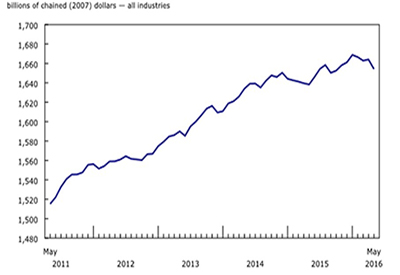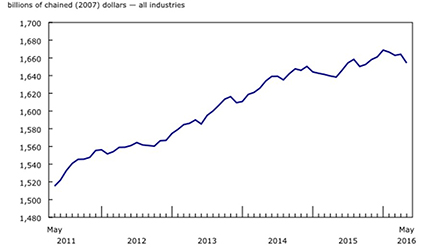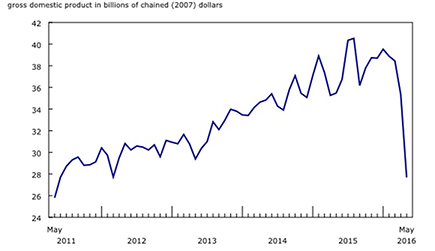GDP Drops 0.6% in May

August 1, 2016
Real gross domestic product (GDP) fell 0.6% in May, the largest monthly decline since March 2009. The decrease was primarily due to lower non-conventional oil extraction, a consequence of the Fort McMurray wildfire and evacuation.
Chart 1: Real gross domestic product falls in May
The Fort McMurray wildfire was the main cause behind a 2.8% decline in the output of goods-producing industries. The mining, quarrying, and oil and gas extraction sector fell 6.4%, as the output of the non-conventional oil extraction industry recorded a 22% drop. Following an 8.1% decrease in April due to maintenance shutdowns at upgrader facilities, the output level in May for this industry was the lowest since May 2011.
Excluding the decline in the non-conventional oil extraction industry, real GDP edged down 0.1% in May. There was little evidence that the Fort McMurray wildfire significantly affected other industries at the national level. Therefore, the difference between the overall 0.6% decline in GDP and the 0.1% decrease in GDP excluding the non-conventional oil and gas industry is an approximation of the direct impact that the Fort McMurray wildfire had on overall growth in May.
Chart 2: Non-conventional oil extraction drops sharply in May
The output of service-producing industries rose 0.3% in May. Wholesale and retail trade, the public sector (education, health and public administration combined), the arts, entertainment and recreation sector, and the finance and insurance sector were up. On the other hand, transportation and warehousing services, and administrative services were down. The Fort McMurray wildfire and evacuation had a minimal impact on most of the service-producing industries at the national level.
For more information on the impact of the Fort McMurray wildfire and evacuation on current production measures of GDP, see the note to readers.
The mining, quarrying, and oil and gas extraction sector drops
In addition to the drop in non-conventional oil and gas extraction, the mining, quarrying, and oil and gas extraction sector recorded decreases in mining except oil and gas extraction (-0.4%) and support activities for mining, and oil and gas extraction (-3.3%).
The decline in mining excluding oil and gas extraction was mainly attributable to lower output at metal ore mines (such as copper and nickel), which offset increases in potash mining. Support activities for mining and oil and gas extraction were down for the fourth consecutive month, primarily due to a decrease in support activities for mining.
In contrast, conventional oil and gas extraction rose 0.6% in May, as most conventional crude petroleum extraction facilities are located outside the areas affected by the wildfire.
Manufacturing output falls
Manufacturing output was down 2.4% in May, the largest decline since January 2009. Both non-durable and durable goods manufacturing recorded significant decreases in May.
Non-durable goods manufacturing fell 2.8%, mainly as a result of a 15% drop in output at petroleum refineries. The decrease at petroleum refineries reflected a loss in availability of crude oil for refining — due to the Fort McMurray wildfire — combined with maintenance and turnaround work at some facilities. Chemical manufacturing (-3.9%) also posted a notable decline.
Durable-goods manufacturing was down 2.1% in May. Declines were widespread among industry sub-groups and occurred for a variety of reasons. Lower output from transportation equipment manufacturers resulted partly from supply interruptions associated with the earthquake in Japan in April, while lower foreign demand influenced the decrease in non-metallic mineral product manufacturing.
Utilities decline
Utilities declined 1.8% in May. Both electric power generation, transmission and distribution, and natural gas distribution industries were down. The decrease in May offset most of the increase in April, which was caused by colder than usual weather in Central Canada.
The public sector rises
The public sector (education, health and public administration combined) rose 0.3% in May, a ninth consecutive monthly increase. The growth in May was primarily the result of gains in public administration due to the 2016 Census. Health services edged up, while education services were unchanged.
Wholesale and retail trade grow
Wholesale trade rose 1.0% in May, a third consecutive monthly increase, as most subsectors posted a gain. Output growth was notable for wholesalers of food, beverage and tobacco, motor vehicles and parts, and personal and household goods. The output of miscellaneous wholesalers and, to a lesser extent, farm product wholesalers declined.
Retail trade grew 0.4% in May, mainly as a result of increases in output at food and beverage stores, clothing and clothing accessories stores, and gasoline stations. Conversely, output declined at motor vehicles and parts dealers, general merchandise stores (which include department stores), and furniture and home furnishing stores.
Construction decreases
Construction decreased 0.7% in May, after essentially no change in April. Residential building construction fell 1.2% in May as fewer single-family dwellings were built. After five straight months of gains, repair construction has declined for three consecutive months. Engineering construction was also down in May, while non-residential building construction was up.
The real estate and rental and leasing sector edged up 0.1% in May, partly as a result of higher output from lessors of real estate. The sector’s rise was tempered by a 2.4% decline in the output of real estate agents and brokers, as home resale activity dropped in most markets, led by those in British Columbia and Ontario.
The finance and insurance sector increases
The finance and insurance sector grew 0.6% in May, a third consecutive monthly gain. The output of insurance carriers was up, reflecting an increase in claims due to the Fort McMurray wildfire. Financial investment services and, to a lesser extent, banking services also rose.
Other industries
Transportation and warehousing services declined 0.2% in May. Rail transportation fell for a third month in a row, reaching its lowest level since July 2013. The decline in rail transportation in May was partly due to a decrease in the movements of grain and fertilizer, metals and minerals, and fuel oils and crude petroleum products. Pipeline transportation of oil fell in May. Some pipelines were shut down as a result of the Fort McMurray wildfire, but this lower output was partially offset by the movement of oil out of inventory, which kept exports steady. In contrast, air transportation rose 1.6%.
The arts, entertainment and recreation sector grew 4.3% in May. The increase was primarily the result of a gain in spectator sports and related industries, as higher attendance at professional basketball and baseball sporting events in May more than offset the decline in April, which was due to the absence of National Hockey League playoff games played in Canada.
Source: Statistics Canada, www.statcan.gc.ca/daily-quotidien/160729/dq160729a-eng.htm?HPA=1.













